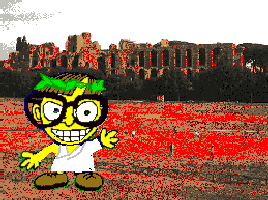In the beginning, Gates said, "Let there be DOS."
 In
"From Pencils to Pixels: The Stages of
Literacy Technology," Dennis Baron notes that "the computer is simply
the latest step in a long line of writing technologies." Heralded
as a boon to grammar instruction, the computer provided acontextual drill
and practice for students in grammar, punctuation, and other mechanical
skills, much like a multiple-choice standardized exam. But computers
soon offered more to students than paper exams could provide: when students
choose the right answer, they might be rewarded by flashing colored lights
or even sounds; choosing the wrong answer might result in video-game like
"death." In other words, the grammar quizzes took on game-like qualities
that were supposed to (and generally did) engage students' attention.
As computer technologies developed, these drill-and-(s)kill "games" also
developed. The problem(s) is (was/were), however, that a) students
quickly became bored as home and arcade video games provided far more "bang
for the buck," moving from text-based adventure games to joystick-driven
audio-and-video phantasias; and b) acontextual drill and practice in the
mechanics of writing does not translate into better writing.
In
"From Pencils to Pixels: The Stages of
Literacy Technology," Dennis Baron notes that "the computer is simply
the latest step in a long line of writing technologies." Heralded
as a boon to grammar instruction, the computer provided acontextual drill
and practice for students in grammar, punctuation, and other mechanical
skills, much like a multiple-choice standardized exam. But computers
soon offered more to students than paper exams could provide: when students
choose the right answer, they might be rewarded by flashing colored lights
or even sounds; choosing the wrong answer might result in video-game like
"death." In other words, the grammar quizzes took on game-like qualities
that were supposed to (and generally did) engage students' attention.
As computer technologies developed, these drill-and-(s)kill "games" also
developed. The problem(s) is (was/were), however, that a) students
quickly became bored as home and arcade video games provided far more "bang
for the buck," moving from text-based adventure games to joystick-driven
audio-and-video phantasias; and b) acontextual drill and practice in the
mechanics of writing does not translate into better writing.
Early computers-and-writing enthusiasts, however, saw the potential of the new writing technologies to encourage student writing in a variety of ways: word processing programs could be used to encourage revision; grammar- and spell-checkers could help to facilitate correctness; and heuristics programs could help students develop and organize their ideas. With the growth of network capabilities, collaborative work was facilitated, and teachers saw the potential of text-based real-time chat discussions and file-sharing capabilities to complement the growing investment in collaboration and group work in the writing classroom (c.f. Hawisher et al.). The Daedalus Group developed the Daedalus Integrated Writing Environment and the rest (as "they" say) is history....